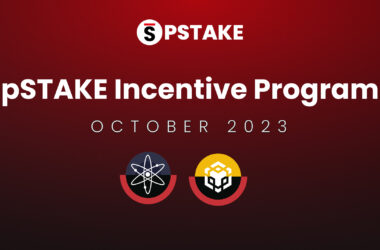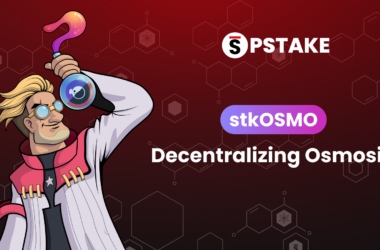TL;DR
- Expansion: pSTAKE is gearing up to launch DYDX liquid staking with stkDYDX.
- Unique Features: stkDYDX has distinctive features:
– Prioritizing dYdX Chain decentralization with pSTAKE’s new automated stake delegation and decentralization strategy
– dYdX aligned liquid staking with potential PSTAKE and DYDX dual governance for stkDYDX
– Best-in-class DYDX staking experience with auto-compounded staking rewards (USDC and DYDX both)
– Improved user experience with unique features such as ‘Flash Unstake’. - Launch Strategy: stkDYDX is expected to launch soon after the dYdX chain upgrades to enable ICA accounts on the chain
- DeFi Integrations: stkDYDX will be intricately woven into the liquidity base of key DEXs like Dexter and Astroport on Neutron, opening the possibilities for multiple other use cases. Plans to integrate stkDYDX into Ethereum LSTfi protocols will also be considered.
The Case for DYDX Liquid Staking
In Q4 2023, dYdX Chain transitioned into a Proof-of-Stake (PoS) network with the launch of dYdX v4, a standalone open-source blockchain software based on the Cosmos SDK and Tendermint Proof-of-Stake consensus protocol (“dYdX Chain”). The primary objective behind this transition was to enhance decentralization.
With the shift to a PoS network, DYDX token holders can now stake their tokens to secure the dYdX Chain, earning staking rewards in USDC tokens. However, it’s important to note that staking DYDX tokens involves a tradeoff, as the funds become locked for an unbonding period of 30 days, rendering them illiquid and unavailable for use in DeFi.
Enter pSTAKE, which addresses this challenge and offers users the best of both worlds—staking and DeFi—while setting itself apart from other Liquid Staking Providers.
Enhancing DYDX Decentralization
Due to the inherent architecture of pSTAKE, stkDYDX will further enhance decentralization for the dYdX chain, which was one of the main reasons for dYdX to transition to a sovereign chain.
It’s a given that decentralization of PoS chains is crucial—resilient network, enhanced security, fair governance, and community trust. One of the best decentralization indicators is the Nakamoto Coefficient (the number of validators that control more than 33.33% of the network’s stake).
For example, the Nakamoto coefficient for the Stargaze network is 13, signifying that 13 validators collectively control more than 33.33% of the network’s stake. Similarly, the Osmosis network has a Nakamoto coefficient of 10, Kujira follows with a coefficient of 9, and the Cosmos Hub has a coefficient of 7. Notably, the dydX network has the lowest Nakamoto coefficient, at only 2.
stkDYDX will launch with pSTAKE’s new automated stake decentralization delegation model that will constantly optimize for decentralization by using various parameters to suggest the final validator set and the amount of stake delegation to each validator in this set.
While there are various delegation models, pSTAKE contributors strongly believe liquid staking providers should not gatekeep validator delegations. Delegation should be driven by transparent on-chain data (source of truth).
Aligning with DYDX Governance
The DYDX token has been in circulation for many years, garnering a dedicated community of holders. The transition to a Proof-of-Stake (PoS) model represents a substantial shift in tokenomics. Under this new model, 100% of the protocol revenue generated on dYdX will be directed back to the stakers. This change, coupled with the introduction of liquid staking, presents a novel landscape for DYDX holders.
Recognizing the significance of these changes, establishing a dual governance model for stkDYDX will be actively considered. While this is still just an idea, this model would primarily be controlled by the native token while not necessarily integrated into the base layer, thereby preserving the transparency of the protocol’s core business functions. The objective is to ensure that some governance and guidance over the liquid staking functionality remain within the purview of dYdX governance, allowing pSTAKE to seamlessly provide Liquid Staking-as-a-Service (LSaaS) for the DYDX community.
Auto-compounding of DYDX Liquid Staking
On the dYdX Chain, all transaction fees (trading fees denominated in USDC, DYDX-denominated gas fees from transactions, and USDC-denominated gas fees from transactions) collected by the protocol are distributed to Validators and Stakers (i.e., DYDX token holders that stake their DYDX to dYdX Chain Validators).
pSTAKE is deployed on the Persistence core-1 chain, the app chain for Liquid Staking DeFi (LSTfi) in Cosmos. Being built on Persistence allows pSTAKE to interact with other dApps like Dexter within the Ecosystem. This is vital to enable auto-compounding of stkDYDX so that users don’t have to claim staking rewards repeatedly and enjoy passive staking yield.
In the case of stkDYDX auto-compounding, all USDC rewards will be converted into DYDX tokens by swapping on the DYDX/USDC pool on Dexter and then staked with pSTAKE after every epoch in the background by the pSTAKE protocol.
Improving DYDX liquid staking User Experience
pSTAKE is committed to innovating and improving LSTfi user experience.
One example is the innovative ‘Flash Unstake’ feature that will allow instant redemptions/unstaking of stkDYDX for DYDX tokens. The notion of LSTs is incomplete if users do not have instant access to native token liquidity. Primarily, this is done by building deep LST/native token liquidity. To go one step further and give pSTAKE users a superior liquid staking experience, pSTAKE allows instant LST redemptions on its dApp directly.
For example, users can instantly redeem stkDYDX for DYDX (paying a small fee) on pSTAKE. This works thanks to a state-of-the-art mechanism that will match daily DYDX deposits into the protocol with daily stkDYDX withdrawal requests.
Navigating the launch
The implementation of stkDYDX is currently underway on pSTAKE devnet, aiming to provide a non-custodial DYDX liquid staking solution within the Cosmos network. Notably, this solution will need ICA accounts enabled on its host chain, dYdX. pSTAKE contributors are diligently tracking the dYdX open-source code. Recent activity on GitHub indicates the addition of ICA accounts, which is expected to be enabled in a future chain upgrade.
Post-launch, pSTAKE’s core objective is to anchor stkDYDX firmly within the Cosmos DeFi Ecosystem. Right from the outset, pSTAKE will seamlessly integrate with key DEXs such as Dexter and Astroport. This strategic integration aims to establish deep liquidity and pave the way for a myriad of additional use cases.
A pivotal aspect of pSTAKE’s post-launch strategy involves exploring integrations with DeFi protocols in the Ethereum ecosystem to enhance alignment with the active and engaged DYDX holders within the Ethereum space. By fostering interoperability between ecosystems, pSTAKE aims to create a seamless and expansive environment for stkDYDX, unlocking opportunities for diverse user bases.
About pSTAKE
pSTAKE is a multi-chain liquid staking protocol that unlocks liquidity for your staked assets. With pSTAKE, you can securely stake your Proof-of-Stake (PoS) assets to earn staking rewards and receive staked underlying representative tokens (stkTokens), which can be used to explore additional yield opportunities across DeFi.
At present, pSTAKE supports Cosmos Hub (ATOM), Binance Chain (BNB), and Osmosis (OSMO) networks’ native tokens, with DYDX, Persistence (XPRT), and Celestia (TIA) support coming soon in the future.
Website | Twitter | Telegram | Blog | YouTube | Forum










